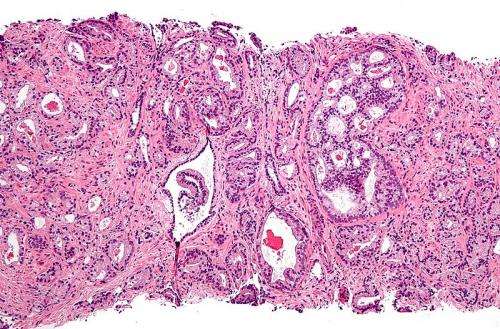Study finds how prostate cancer cells mimic bone when they metastasize

Prostate cancer often becomes lethal as it spreads to the bones, and the process behind this deadly feature could potentially be turned against it as a target for bone-targeting radiation and potential new therapies.
In a study published online Tuesday in the journal PLOS ONE, Duke Cancer Institute researchers describe how prostate cancer cells develop the ability to mimic bone-forming cells called osteoblasts, enabling them to proliferate in the bone microenvironment.
Attacking these cells with radium-233, a radioactive isotope that selectively targets cells in these bone metastases, has been shown to prolong patients' lives. But a better understanding of how radium works in the bone was needed.
The mapping of this mimicking process could lead to a more effective use of radium-233 and to the development of new therapies to treat or prevent the spread of prostate cancer to bone.
"Given that most men who die of prostate cancer have bone metastases, this work is critical to helping understand this process," said lead author Andrew Armstrong, M.D., director of research at the Duke Cancer Institute Center for Prostate and Urologic Cancers.
Armstrong and colleagues enrolled a small study group of 20 men with symptomatic bone-metastatic prostate cancer. When analyzing the circulating tumor cells from study participants, they found that bone-forming enzymes appeared to be expressed commonly, and that genetic alterations in bone forming pathways were also common in these prostate cancer cells.
They validated these new genetic findings in a separate multicenter trial involving a larger group of more than 40 men with prostate cancer and bone metastases.
Following treatment with radium-223, the researchers found that the radioactive isotope was concentrated in bone metastases, but tumor cells still circulated and cancer progressed within six months of therapy. The researchers found a range of complex genetic alterations in these tumor cells that likely enabled them to persist and develop resistance to the radiation over time.
"Osteomimicry may contribute in part to how prostate cancer spreads to bone, but also to the uptake of radium-223 within bone metastases and may thereby enhance the therapeutic benefit of this bone targeting radiotherapy," Armstrong said. He said by mapping this lethal pathway of prostate cancer bone metastasis, the study points to new targets and thus critical areas of research into designing better tumor-targeting therapies.















